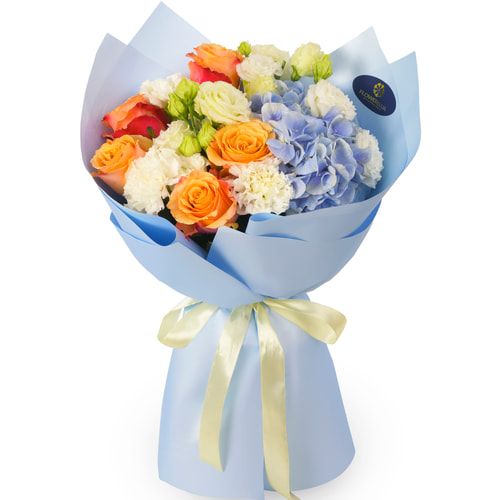Flowers similar to daisies: names, descriptions and photos
Daisies are touching and at the same time simple wild flowers that serve as an unobtrusive decoration of the local area. However, not everyone knows that they have a lot of doppelgangers differing in size and bud color. Daisy-like flowers are the result of the leading breeders’ work. Each relative of chamomile is unique in its own way, and our specialists will always help you with the choice of the best wildflowers. In addition, they will advise you as to what seasonal flowers in Lviv will suit a special occasion.
Daisies of Different Colors
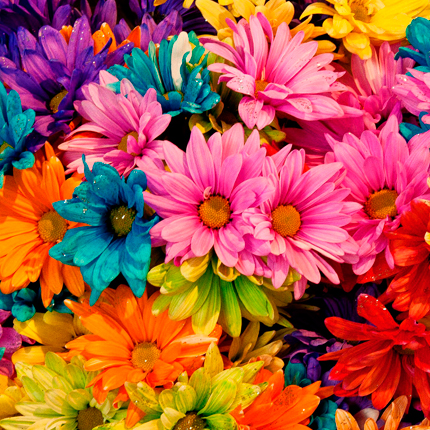
These daisies have their own unique names. However, almost all of them are easily grown and take root in the Eastern European conditions, so a bright chamomile flowerbed is guaranteed. If you want to know exactly what these daisies are called, you’ve come to the right place.
Blue Daisies
While the pharmacy (decorative) chamomile has white petals, the asters or cineraria similar to it have blue ones. Remarkably, cineraria boasts the white and blue two-color buds.
Colored Daisies
Anemone Blenda (Anemone coronaria) is a multi-colored chamomile, the petals of which can be seen in lilac-white, light blue-deep blue, white-violet, and other double colors.
Yellow Daisies
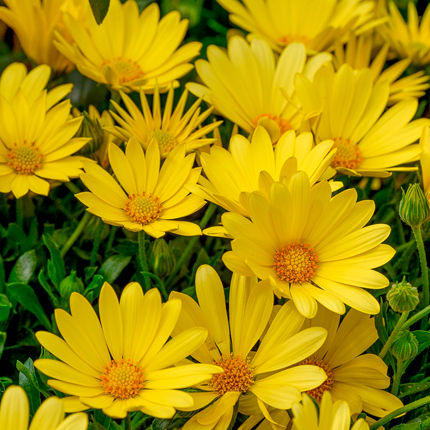
Yellow daisies are, as a rule, doronicums. However, pyrethrums with lemon buds and petals that are velvety to the touch can also be seen sometimes.
Purple and Lilac Daisies
Purple petals are most often seen on asters and osteospermums. The shade of lilac and its saturation depend on a particular plant variety. If you are looking for border decorations, look no further than the osteospermums. These compact shrubs grow densely, have clear forms, and look neat in any plantings.
Red and Pink Daisies
Red and pink daisies are usually pyrethrums. These flowers are undemanding and feel good in places with bright lighting and a little shadow. However, the petals may fade from direct sunlight.
Other Types of Flowers Similar to Daisy

Below we will provide examples of different plants that look so much like daisies, but in fact are completely different specimens.
Anacyclus
Anacyclus belongs to the Asteraceae family and is actually very similar to daisies. In total, there are approximately 10 subspecies of anacyclus (annual and perennial) with white buds up to 5 cm (0.2 ft.) in diameter. The main difference between anacyclus and chamomile is that the inside of the petals is not white, but pink.
Anacyclus grows as a small creeping shrub with erect pedicels. The plant lives according to the sun; it opens its buds early in the morning and closes them at sunset. The petals also close during rainfall. Anacyclus should be grown in areas with loose soil, good drainage, and plenty of light.
Arctotis
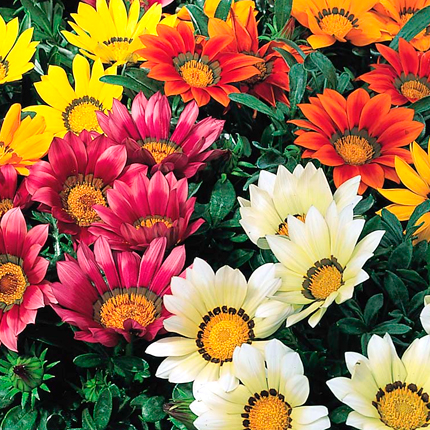
Arctotis is a perennial compact shrub with stems up to 120-130 cm (3.9-4.3 ft.) high. However, if the growing conditions are poor, the plant may not exceed 25 cm (0.8 ft.) in height. There are two varieties of arctotis: stoechadifolia and hybrid. The flowers are distinguished by an unusual two-tone color of the petals: bronze or red at the core and yellow at the edges, with a smooth transition of shades. Arctotis is very fond of light, but on cloudy days it doesn’t open its buds at all. For this reason, it is necessary to plant it in places with an abundance of sunlight. Arctotis prefers stony soils, is unpretentious, and calmly survives both cold snaps and droughts. The flowering period falls on mid-summer – late September.
Venidium
Venidium also belongs to the Asteraceae family. The plant differs from the classic chamomile in a larger dark brown core and the base of the petals coming in a rich red tone. Additionally, the subspecies with pink or orange petals can be seen sometimes. The bud itself is about 10 cm (0.3 ft.) in diameter, and the height of the entire plant reaches 80 cm (2.6 ft.). The flowering period is long: from mid-summer until the onset of frost. As a rule, Venidium is grown not in flower beds, but in containers or pots.
Gazania
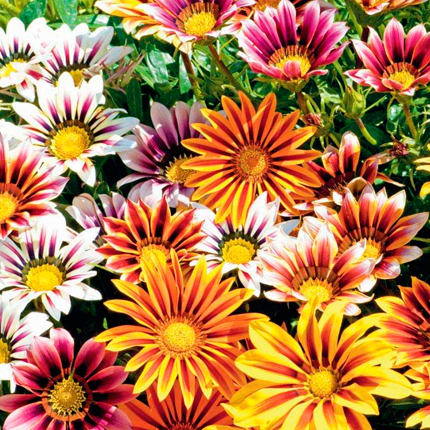
This amazing flower has many colors, ranging from milky and orange to red, purple, and even lemon. Additionally, there are two-color varieties of gazania, like certain types of lilies. In total, about 40 plant varieties are known, and all of them delight the eye with long flowering (from late spring to the onset of frost). The plant calmly withstands drought; it is a compact shrub up to 40 cm (1.3 ft.) in height. You can grow gazania in a flower bed or flowerpots.
Erigeron
Erigeron is a perennial plant belonging to the Asteraceae family. Its popular name (“small-petaled”) directly reflects the appearance of its buds. Numerous narrow petals around the entire perimeter surround the yellow core and can grow in a couple of rows. The long pedicels are covered with fine pile. The leaves are concentrated in the basal rosette. Each leaf can be from 10 to 20 cm (0.3-0.7 ft.) in length. The petal shade varies from snow-white, pale pink, and purple, to dark purple.
Daisy-Flowering Helichrysum
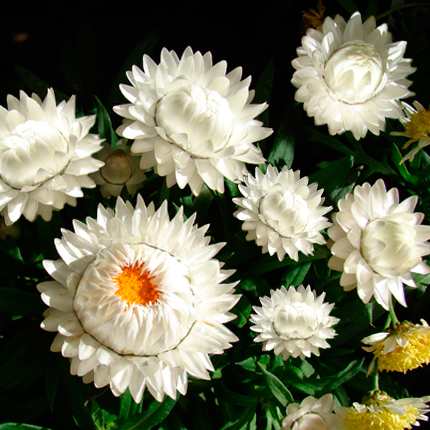
This is a ground cover perennial or annual plant native to New Zealand. It features silvery-green stalks and leaves, as well as white petals. Helichrysum doesn’t exceed 10 cm (0.3 ft.) in height, but it grows in breadth up to 50 cm (1.6 ft.). The flowering lasts 3 summer months. There are several varieties of the plant, including the exotic (selago, coral, Milford).
Gerbera
These beloved flowers look like large daisies and belong to the Asteraceae family. The buds of the plant amaze with their color palette. Gerbera petals come in all colors and shades of the rainbow, except for blue. Their shape is tubular, narrowed, or curly.
Gerberas should be grown in well-lit beds. Even allergy sufferers can be presented with a chic bouquet of these flowers.
Doronicum
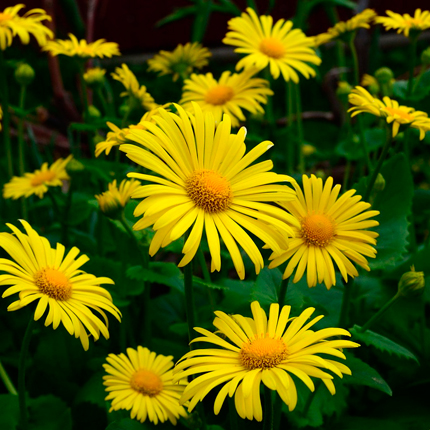
The bright yellow or orange buds of this plant reach 10 cm (0.3 ft.) in size, and the cut flowers look like freshly taken from the garden for a long time. Due to this peculiarity, doronicums are so often present in bouquets and flower arrangements, harmonizing well with other flower varieties. The shrub itself can grow to a mark of 30-100 cm (1-3.3 ft.), depending on the subspecies. The leaves are triangular in shape with a beautiful emerald overflow.
Calendula (Marigold)
Calendula is a popular medicinal plant that is easy to grow. It belongs to the Asteraceae family. Calendula grows in large numbers in the Eastern European region and is represented by several subspecies, of which a group of tall (up to 70 cm / 2.3 ft. in height) and undersized (up to 30 cm / 1 ft. in height) specimens stands out. The buds have a diameter of about 5 cm (0.2 ft.); the petals are rich orange. When growing the plant, keep in mind that it is self-seeding and quickly populates large areas. If you don’t want your garden to be “invaded” by calendula, you will have to take the timely action.
Cosmos
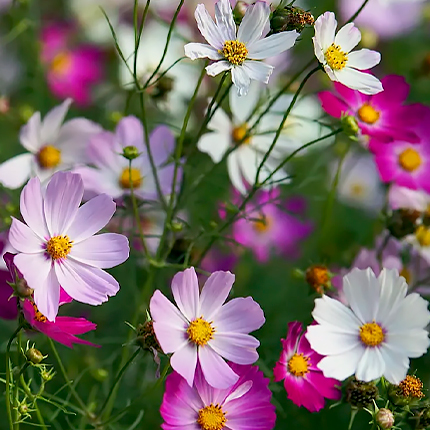
A tall flowering plant that can be 100 or 150 cm (3.3 or 5 ft.) long. This annual and perennial flower is unpretentious and capable of self-sowing. Cosmos can grow and develop well even on depleted soils, enduring frosts and strong winds. The buds reach 5 cm (0.2 ft.) in diameter; the petals come in snow-white, pink, purple, or red. In total, there are about 20 varieties of cosmos in nature.
Coreopsis
Another tall relative of chamomile that is up to 100 cm (3.3 ft.) high. Coreopsis blooms in mid-summer and continues until November. The bud diameter is 5-7 cm (~0.2 ft.). The color of the petals is bright; all specimens resemble the sun and can be either pale yellow or rich orange. The surface of the petals is either ordinary or velvety. Coreopsis grows densely and serves as an excellent decoration for large flower beds.
Felicia

Due to their unusual hue, these blue daisies are often used in landscape design. In the Eastern European region, two subspecies of felicia are cultivated: amelloides and bergeriana. The first is a perennial, which in such climatic conditions has turned into an annual due to its inability to survive frosts. However, you can save Felicia amelloides from the winter by completely cutting off the plant and placing it in a container with a biosubstrate. The container can then be stored in a dark place. A mature plant reaches 50-60 cm (1.6-2 ft.) in height, has rough gray leaves, and blooms with blue-turquoise flowers. Felicia bergeriana, or tender felicia, is much lower than Felicia amelloides (up to 15-20 cm / 0.5-0.7 ft.), but grows very actively in width. The shape and color of the leaves are similar, except for their size. The inflorescences are blue or light blue, with a bright yellow center.
Marguerite
Marguerites, as a rule, don’t even grow up to 50 cm (1.6 ft.) in height. The plants bloom with fluffy buds having white, pink, orange, purple, red, or yellow petals. The shape of the buds and the density of the petals vary slightly, depending on the specimen properties. The flowering period is very long: from March to the first frost. Marguerites are quite undemanding to growing conditions and care. These fragile and delicate flowers look great both in homogeneous flower beds and next to other plants.
Ox-Eye Daisy
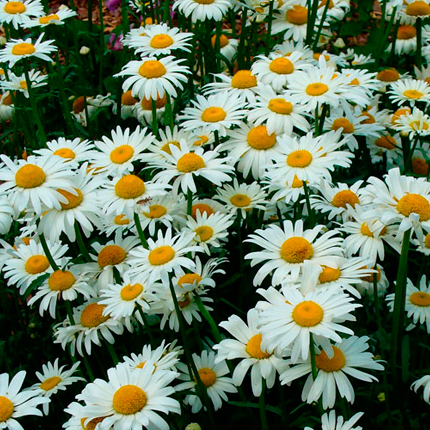
Ox-eye daisy is popularly called “garden chamomile”. The plant belongs to the Asteraceae family and is quite popular with flower growers. Ox-eye daisy takes root in any soil, calmly tolerates frosts and dry weather, and is also unpretentious. The plant can reach 100-120 cm (3.3-4 ft.) in height, depending on the specimen properties. A distinctive feature of ox-eye daisy is the flowering, which can be observed twice a year, in May and September. One way or another, the plant blooms with large buds (about 10 cm / 0.3 ft.). The petals are white, and the core is yellow.
Osteospermum
Osteospermum is also called “Cape daisy” or “African daisy”. This heat-loving plant prefers well-lit beds; however, it can grow well even in regions with a small number of sunny days per year. Cloudy weather and rains don’t affect the decorativeness of this flower. It is better to plant it into a breathable substrate with a high content of humus. The flowering begins in May and continues up to late October – early November. Osteospermum withstands short-term frosts, but gardeners recommend moving the pot with the flower into the house or digging it out of the flower bed for the winter. There are perennial and annual osteospermums with a height of 30 to 100 cm (1 to 3.3 ft.); the stems grow shorter in the bright light than in the shade. The buds are very similar to daisies (about 5 cm / 0.2 ft. across). The petal color is represented by pink, yellow, purple, and orange hues; very often the color is two-tone. The middle of the flower is unusual (dark purple).
Pyrethrum
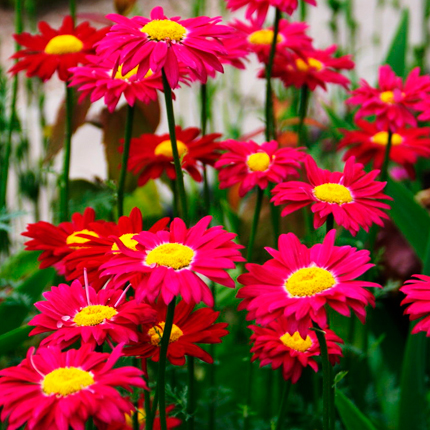
This perennial or annual herbaceous plant belongs to the Asteraceae family. It grows as a small but branched shrub with erect stems up to 25 cm (0.8 ft.) high. The flowers bloom in corymbose inflorescences. The buds of different varieties deviate from each other, but most often their diameter is 7-8 cm (0.2-0.3 ft.), and the petals come in white, light pink, raspberry, or red colors. The leaf plates are green-yellow. Pyrethrum is easily grown from seed, cuttings, or by self-seeding. A distinctive feature of the plant is its rich aroma.
Ornamental Sunflower
Ornamental sunflower, or “sunny flower”, can indeed be easily confused with chamomile. Its buds reach 3-5 cm (0.1-0.2 ft.) in diameter, and the petals are rich yellow or closer to orange. The flower can grow up to 3 m (9.8 ft.) in height, but there are also dwarf subspecies. Ornamental sunflowers are most often planted along the borders, next to deciduous trees, or in flower beds. The flower goes well with other brightly colored ones. The only condition is that the growth of the plant must be carefully monitored. Otherwise, the sunflower plantations may become too large, and the neighboring plants will simply be crowded out.
Jerusalem Artichoke
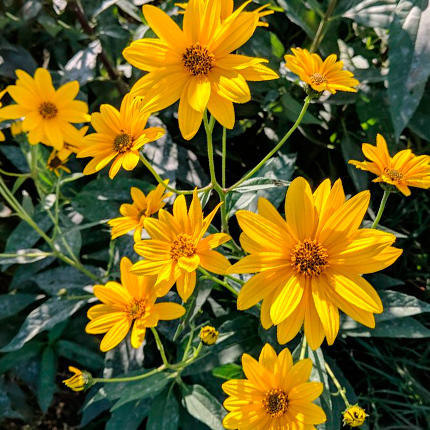
Jerusalem artichoke, or tuberous sunflower, is a perennial herbaceous plant that is both ornamental and edible. However, unlike the common sunflower, both the top and the root of Jerusalem artichoke are suitable for consumption. The plant blooms in August and fades at the end of September. The inflorescences consist of long narrow yellow petals. It is a hardy crop that endures frosty winters.
Rudbeckia
Another bright representative of the Asteraceae family. The height of rudbeckia varies from 0.5 to 2 m (1.6-6.6 ft.), and the diameter of the buds is 10-12 cm (0.3-0.4 ft.). The petals come in milky, pink, yellow, orange, or red-brown colors. There are also bicolor varieties with darker petal bases. The flowering period of the plant lasts two months, from August to September. The perennial grows well in one area for about 5-6 years.
Ursinia
The homeland of the bright ursinias is South Africa. According to external signs, the plant is very similar to chamomile, only the flowers are yellow, and the leaves are rich green. The distinctive feature is that the underside of ursinia’s petals is lighter than the top. For example, if the visible part of the flower is yellow-brown, then the wrong side is yellow or reddish-yellow. Ursinia grows up to 50-60 cm (1.6-2 ft.), but there are also shorter varieties (about 30 cm / 1 ft.). The diameter of the inflorescences is 5 cm (0.2 ft.). The plant endures the bad weather and cold quite well. The flowering lasts the entire warm season and until November.
Chrysanthemum

There are annual and perennial chrysanthemums, the different varieties of which deviate in height and size of flowers. There exist the 1.5 m (5 ft.) chrysanthemums, and the low shrubs. The buds with densely growing petals come in a wide variety of colors: white, yellow, lilac, pink, purple, and so on. When growing chrysanthemums, make sure that they get a lot of light and the soil is sufficiently moist. Florists love these plants due to their ability to remain attractive for a long time when cut.
Chrysanthemum Arcticum
This is a dwarf variety of chrysanthemum that grows up to a maximum of 30 cm (1 ft.) in height. It pleases the eye with its flowering all autumn, starting from the end of September. The buds of the arctic chrysanthemum are very similar to daisies; however, they are sometimes not white, but light lilac. The plant grows very quickly, forming green floral carpets. It prefers good lighting and nutrient soils.
Korean Chrysanthemum
These are perennial small-flowered hybrid chrysanthemums, which have various subspecies that differ in the flowering period, shrub height, shape and color of the buds. On average, Korean chrysanthemums grow up to 30-50 cm (1-1.6 ft.). The flowering can be observed not earlier than the end of summer. The plant loves good lighting and doesn’t tolerate strong winds.
Echinacea
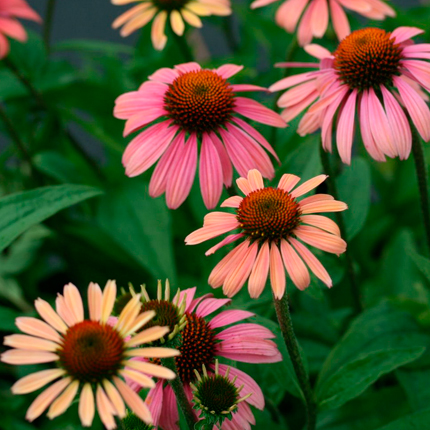
Echinacea purpurea is the most common variety. However, the buds of the plant will not necessarily be exactly purple. Milk, yellow, and red-colored inflorescences are also found. All Echinacea inflorescences have a convex core and slightly lowered petals. The plant can grow up to 150 cm (5 ft.) in height and blooms from mid-summer to late September. These flowers can be grown from seeds and cuttings.
Zinnia
In total, there are about 20 types of zinnias, and all of them have colorful, fluffy buds of large sizes. Each variety has its own characteristics, including single, semi-double, and double petals in white, pink, purple, golden, red, dark red, or burgundy. There are miniature zinnias (up to 20 cm / 0.7 ft. high), medium (up to 50 cm / 1.6 ft.), and tall (up to 100 cm / 3.3 ft.). Zinnias grow in branched shrubs in their natural habitat, while garden species are represented by more compact annual plants.
These flowers are very hardy. They will be able to grow and develop even in waterlogged soil, at high temperatures and in direct sunlight. Zinnias will also not lose their brightness even during a prolonged drought. The cut flowers retain their freshness in compositions for weeks.
Asters
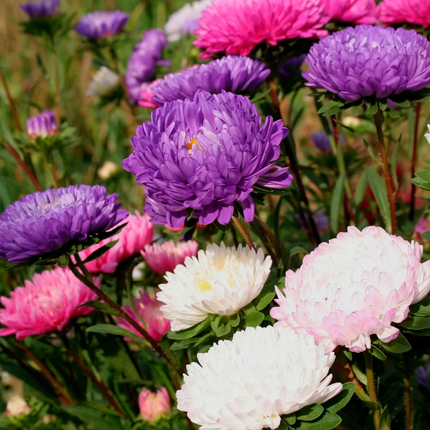
This genus of herbaceous plants of the Asteraceae family is associated by many with fluffy basket-like inflorescences, which bear little resemblance to daisies. However, many aster varieties simply became unrecognizable thanks to the hard work of breeders. The Margaret variety, which has a bright yellow core and scarlet, pink, sky-colored, purple, yellow, or snow-white petals, is quite popular with gardeners. Among the dwarf representatives of the genus, the Waldersee, Pepito, and Edelweiss varieties have become especially popular. These shrubs don’t exceed 25 cm (0.8 ft.) in height, and the buds reach 4-5 cm (0.1-0.2 ft.) in diameter. If you like flowers with large inflorescences, pay attention to the Madeleine and Sonenstein asters.
All asters are unpretentious, sensitive to cold snaps, and love moderately moist soils. They look great both in single and in group plantings. The miniature varieties often decorate borders and ridges; the medium and tall ones, rockeries and mixborders. Additionally, asters can be grown in flowerpots or boxes, placed on the terrace or in the gazebo. When cultivating asters, keep in mind that the plants quite often suffer from fungal diseases such as fusarium and blackleg. To prevent them, it is recommended to treat the plant with a solution of potassium permanganate (1%), and sprinkle the soil near the flowers with river sand.
All of the above plants are only a small part of the big Asteraceae family, every representative of which strongly reminds us of daisies. However, all of them are united by the unpretentiousness in terms of growing conditions and care, resistance to adverse weather, and the beauty of flowering. If you want to decorate your flower garden, flower bed, house territory, or front garden with bright plants that will bloom all summer and autumn, pay attention to flowers that look like daisies.
